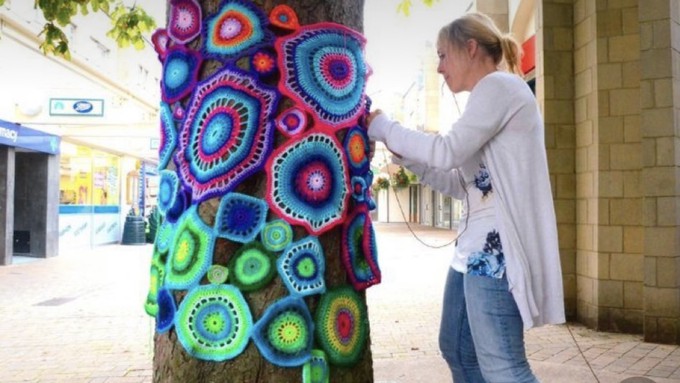
Sacramento textile artists host colorful array at Shepard Center

Ever been to a yarn bombing? Local textile artists will attach yarn pieces to McKinley Park's trees on Saturday morning. Courtesy SCTA
On Saturday, June 8, the Sacramento Center for the Textile Arts hosts a triple-header of activities. It starts with the group’s annual “Yarn Bombing in Bloom” installation at 9 a.m. Members will decorate trees around Shepard Center with handmade yarn flowers and other crocheted decorations.
Local textile artists – specifically knitters, crocheters and needle workers – will attach yarn pieces to trees with more yarn. The installation is expected to stay on display for a month, adding some extra color to the park’s trees.
Activities then shift from a rainbow of yarn to deep, dark denim blue. Starting at 10 a.m. Saturday, the group will hold its “Indigo Dip Dye Day” on the center’s patio. The public is invited to dye their own bandanna or fat quarters, but snag a reservation right away. Those dye tubs can get crowded.
The Indigo Dip Dye Day will be led by indigo expert LuAnne Hansen, who also provides all instruction. Fee for this one-hour workshop is $27 and includes all materials. Time blocks are staggered through 2 p.m. (Make sure to wear old clothing; indigo stains!)
After indigo comes the white elephants, or in this case, “Art Elephants.” From 10 a.m. to 2 p.m. inside Shepard Center, SCTA hosts its annual “Art Elephant Sale,” with dozens of vendors offering unique items. Find materials and tools for all sorts of arts and crafts plus some unusual results of projects. Admission is free.
Located in the north panhandle of McKinley Park, Shepard Center is at 3330 McKinley Blvd., Sacramento.
Details including a link for Indigo Dye reservations: https://sactextilearts.org/.
Comments
0 comments have been posted.Sacramento Digs Gardening to your inbox.
Food in My Back Yard Series
May 6: Maintain soil moisture with mulch for garden success
April 29: What's (already) wrong with my tomato plants?
April 22: Should you stock up on fertilizer? (Yes!)
April 15: Grow culinary herbs in containers
April 8: When to plant summer vegetables
April 1: Don't be fooled by these garden myths
March 25: Fertilizer tips: How to 'feed' your vegetables for healthy growth
March 18: Time to give vegetable seedlings some more space
March 11: Ways to win the fight against weeds
March 4: Potatoes from the garden
Feb. 25: Plant a fruit tree now -- for later
Feb. 18: How to squeeze more food into less space
Feb. 11: When to plant? Consider staggering your transplants
Feb. 4: Starting in seed starting
Sites We Like
Garden Checklist for week of May 11
Make the most of the lower temperatures early in the week. We’ll be back in the 80s by Thursday.
* Plant, plant, plant! It’s prime planting season in the Sacramento area. Time to set out those tomato transplants along with peppers and eggplants. Pinch off any flowers on new transplants to make them concentrate on establishing roots instead of setting premature fruit.
* Direct-seed melons, cucumbers, summer squash, corn, radishes, pumpkins and annual herbs such as basil.
* Harvest cabbage, lettuce, peas and green onions.
* In the flower garden, direct-seed sunflowers, cosmos, salvia, zinnias, marigolds, celosia and asters. (You also can transplant seedlings for many of the same flowers.)
* Plant dahlia tubers.
* Transplant petunias, marigolds and perennial flowers such as astilbe, columbine, coneflowers, coreopsis, dahlias, rudbeckia and verbena.
* Keep an eye out for slugs, snails, earwigs and aphids that want to dine on tender new growth.
* Feed summer bloomers with a balanced fertilizer.
* For continued bloom, cut off spent flowers on roses as well as other flowering plants.
* Add mulch to the garden to maintain moisture. Mulch also cuts down on weeds. But don’t let it mound around the stems or trunks of trees or shrubs. Leave about a 6-inch-to-1-foot circle to avoid crown rot or other problems.
* Remember to weed! Pull those nasties before they set seed.
* Water early in the day and keep seedlings evenly moist.